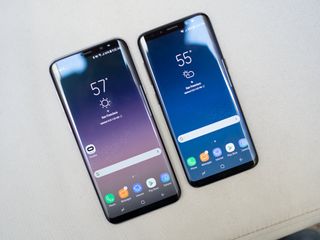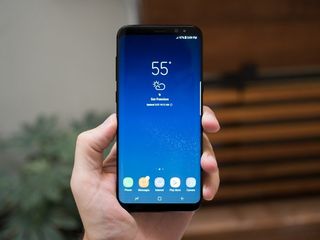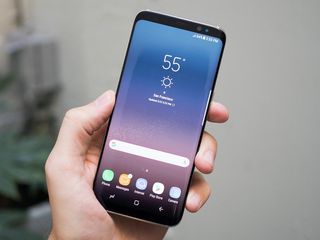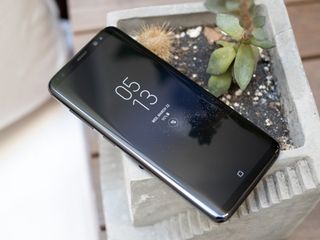Should you buy the Galaxy S8 or the Galaxy S8+?

Are the Galaxy S8 and Galaxy S8+ two distinct phones, or one phone in two sizes? Last year, there were clear demarcations in Samsung two-phone strategy; in 2017, that delineation is a bit more diffuse.
This is especially true because both phones are basically just massive AMOLED panels covered by curved glass and surrounded by metal. Gone is the distinction between flat and curved screen, between value and premium. The most important, and popular, high-end Android phones in the world are now separated merely by 0.4 inches in diagonal screen real estate and 16.6% of additional battery.
So, who should buy the Galaxy S8 and who should opt for the slightly larger, longer-lasting Galaxy S8+? Let's take a look.
First, the specs
| Category | Galaxy S8 | Galaxy S8+ |
|---|---|---|
| Operating System | Android 7.0 Nougat | Android 7.0 Nougat |
| Display | 5.8-inch AMOLED 2960x1440 (570 ppi) | 6.2-inch AMOLED 2960x1440 (529 ppi) |
| Processor | Qualcomm Snapdragon 835 or Samsung Exynos 8895 | Qualcomm Snapdragon 835 or Samsung Exynos 8895 |
| Storage | 64GB (UFS 2.1) | 64GB (UFS 2.1) |
| Expandable | microSD up to 256GB | microSD up to 256GB |
| RAM | 4GB | 4GB |
| Rear Camera | 12MP Dual Pixel, f/1.7 1.4-micron pixels OIS | 12MP Dual Pixel, f/1.7 1.4-micron pixels OIS |
| Front Camera | 8MP, f/1.7 auto focus | 8MP, f/1.7 auto focus |
| Connectivity | Wi-Fi 802.11ac MIMO Bluetooth 5.0 NFC, GPS, Glonass, Galileo, BeiDou LTE Cat.16 | Wi-Fi 802.11ac MIMO Bluetooth 5.0 NFC, GPS, Glonass, Galileo BeiDou LTE Cat.16 |
| Charging | USB-C Fast charging Qi wireless Powermat wireless | USB-C Fast charging Qi wireless Powermat wireless |
| Battery | 3000mAh | 3500mAh |
| Water resistance | IP68 rating | IP68 rating |
| Security | One-touch fingerprint sensor Iris scanner Samsung KNOX | One-touch fingerprint sensor Iris scanner Samsung KNOX |
| Dimensions | 148.9 x 68.1 x 8 mm | 159.5 x 73.4 x 8.1 mm |
| Weight | 155 g | 173 g |
As you can see, the only notable differences between the phones are in the screen size, battery size, and overall footprint: the Galaxy S8+ is 10.6 mm taller and 5.3 mm wider than the Galaxy S8, to accommodate the 6.2-inch screen over the other's 5.8 inches, and has a battery 500mAh larger. It also weighs a scant 18 grams more, at 178g.
A few words on size


Unlike previous Galaxy devices, this year's models have a strange-sounding 18.5:9 aspect ratio. In real-world terms, all that means is that they're unusually tall, and at first feel odd to the average smartphone user accustomed to a particular weight distribution. The change also means that the screens can have larger surface areas without necessarily needing to be widened, something that we see in its extreme with the larger Galaxy S8+.
Who should buy the Galaxy S8+?

Because of what we said above, those looking into the Galaxy S8+ should keep in mind that the phone may be, in its tallness and with the placement of the fingerprint sensor (which is already difficult to reach on the regular Galaxy S8), uncomfortable to access.
If battery if your primary concern, the Galaxy S8+ is your safe choice.
But in that compromise you get a phone that is, in relation to other phones with 6.2-inch screens, relatively compact. While 16:9 media will either need to play with bars on the sides, or be cropped slightly to fit the new aspect ratio, there aren't many other phones on the market right now that offer the sheer level of screen-to-body efficiency as the Galaxy S8+. This is practically a small tablet in the frame of a moderately sized phone — and some will gravitate to it just for this.
Be an expert in 5 minutes
Get the latest news from Android Central, your trusted companion in the world of Android

The Galaxy S8+, with its bigger body, also fits a larger battery: inside is a 3,500mAh cell that matches the Galaxy Note 7 (RIP), and comes in 3% smaller than the Galaxy S7 edge. Still, with a more efficient chip, this is the longest-lasting Galaxy device to date), and therefore the one to get if uptime is paramount.
Of course, with those extra powers come extra dollars, and the Galaxy S8+ is $100 more expensive than its smaller counterpart. Last year, the Galaxy S7 edge justified its additional expense, but with both the Galaxy S8 and S8+ sporting curved glass screens and big, high-resolution displays, it may be more difficult to do so in 2017.
Who should buy the Galaxy S8?

Most people. Everyone. You.
Last year, the Galaxy S7 edge had clear advantages over the S7. This year, not so much.
We don't want to undermine the attractiveness of the Galaxy S8+ — it's a great big phone with lots going for it — but unless you absolutely need the additional battery capacity, the Galaxy S8 is the phone to go for.
Not only is it more much compact and one hand-friendly than the S8+, but it's cheaper. And the Galaxy S8's fingerprint sensor, despite being located in an awkward position around back, is not as difficult to reach.

Last year, the Galaxy S7 had clear disadvantages over the S7 edge: it was considerably smaller, and lacked a curved display. And while the compact phone was easy to use in one hand, it was to many people too small to fulfil the phablet aspirations so many early adopters crave. The Galaxy S8 checks all of those boxes, sharing the same basic platform as its larger counterpart.
A 5.8-inch display is larger than nearly every Android phone on the market right now, but Samsung manages to do so without increasing the overall size of the phone beyond a typical 5.2- or 5.3-inch device. (Of course, a 5.8-inch phone in an 18.5:9 aspect ratio isn't exactly 5.8 inches diagonally, but it's close enough that we shouldn't quibble.)
Wrapping it up

This year, both the Galaxy S8 and Galaxy S8+ are fantastic phones. Really, they are largely without compromise. But it's clear from the get-go that there are fewer reasons than ever to spring for the more-expensive Plus variant, especially since, at 5.8 inches, the regular Galaxy S8 has more than enough screen real estate for most people.
The person who should buy the Galaxy S8+ is someone who needs his or her phone to last as long as possible, who may not have access to a charger — wireless or wired — throughout the day. Or, it's someone who requires as much screen real estate as possible, perhaps to replace a small tablet.
For everyone else, we recommend the Galaxy S8.
Everything you need to know about the Galaxy S8 and S8+
Daniel Bader was a former Android Central Editor-in-Chief and Executive Editor for iMore and Windows Central.
